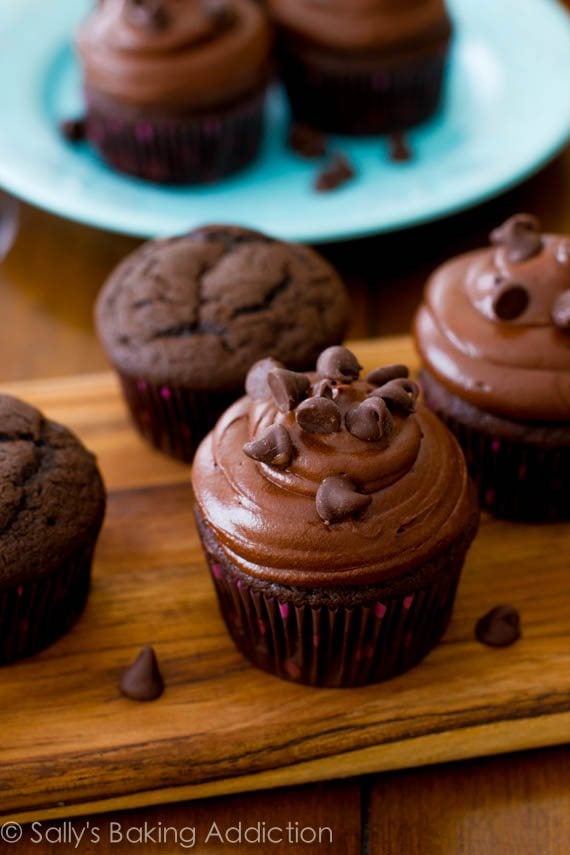Dark chocolate cupcakes topped with dark chocolate frosting. Chocolate lovers only!
This recipe is dedicated to all of you chocoholics.
Pure, unadultered, inexplicable, out-of-this-world love for chocolate.
I know many of you adore chocolate. My most popular cake recipe is – chocolate! My
Triple Chocolate Layer Cake recipe is what inspired me to make these death by chocolate cupcakes. Today’s cupcakes are a different recipe than that cake, but they are just as rich, fudgy, and decadent.
They are dark chocolate cupcakes with a thick dark chocolate frosting on top and sprinkled with chocolate chips. The cupcakes are not overly sweet – they are deep and intense. Pure chocolate. And a lot of it!
I have made about 7 batches of chocolate cupcakes so far this summer. I am not exaggerating! Some batches ran over the sides and looked more like brown mushrooms, not cupcakes. Others did NOT taste like chocolate. Others were crunchy on top (eww!), dry, bland, and blah. Blah blah blah. I have been searching and testing and testing (and testing some more!) to find that perfect chocolate cupcake recipe. Finally, I took a few things I’ve learned from all my mistakes to come out with the best. I only give you the best of the best!
I’ve brought you chocolate cupcakes before on my website.
These chocolate cupcakes are loved by many of you! And
these chocolate cupcakes are quick, easy, and ultra moist. Both chocolate cupcake recipes are fantastic! However, I did not develop either of them on my own.
Today’s new recipe produces rich, moist, and flavorful cupcakes. I use a mix of melted chocolate and cocoa powder to make these cupcakes ultra fudgy. I nearly double the amount of cocoa powder than previous recipes that I’ve tried this summer. 2 eggs, brown sugar, and buttermilk gives each bite a tender, moist texture. They are the complete opposite of dry and bland!
Buttermilk is required for this recipe - the lactic acid present is what will allow the baking soda to react and leaven the cake.
Don’t have buttermilk? You can make your own. Measure 2 teaspoons of white vinegar or lemon juice in a measuring cup. Then, add enough milk (1%, 2%, or whole) to the same measuring cup until it reaches 1/2 cup. Stir it around and let sit for 5 minutes. The homemade “buttermilk” will be somewhat curdled and ready to use in your recipe.
The batter for the cupcakes is very thick. I’m warning you now! Very thick – almost like frosting or chocolate pudding. Just taste it. You KNOW you’ll have amazing cupcakes after you taste the batter. So deliciously fudgy.
The frosting I use for these cupcakes is one of my favorites. It’s the same frosting recipe that I often use to frost my
peanut butter cupcakes. The wonderful thing about this frosting is that there is not that much butter in it. It’s not a buttercream frosting. It’s pure, thick chocolate. Like melted fudge, but thicker. You all love it so much.
I could eat this dark chocolate frosting with a spoon and be happy for the rest of my life.
It’s ultra smooth and velvety. One of the best frostings I’ve ever had.
I piped the frosting on with
Wilton tip #12. I use this tip almost exclusively on my cupcakes.
I am in LOVE with these chocolate cupcakes. By far my favorite chocolate cupcake recipe. I made a version of them for my cookbook (coming out spring 2014) – you will LOVE what I did with them.

Trust me, you have to try these chocolate cupcakes. Soft, moist, tender, intensely fudgy, chocoholic-heaven! Everything about this recipe is perfection to me and I know you will adore each and every bite, too.
Chocoholics unite!

Ingredients:
DARK CHOCOLATE CUPCAKES
- 1/2 cup (1 stick or 115g) unsalted butter
- 2 ounces semi-sweet baking chocolate
- 1/2 cup (64g) unsweetened cocoa powder (not Dutch processed)
- 3/4 cup (95g) all-purpose flour*
- 1/2 teaspoon baking soda
- 3/4 teaspoon baking powder
- 1/4 teaspoon salt
- 2 large eggs, at room temperature*
- 1/2 cup (100g) granulated sugar
- 1/4 cup (50g) light brown sugar
- 1 teaspoon vanilla extract
- 1/2 cup (120ml) buttermilk*
DARK CHOCOLATE FROSTING
- 2 and 3/4 cup (330g) confectioners' sugar
- 2/3 cup (80g) unsweetened cocoa powder
- 6 Tablespoons (90g) unsalted butter, softened to room temperature
- 6 Tablespoons (95ml) heavy cream
- 1 teaspoon vanilla extract
- 1/3 cup (60g) semi-sweet chocolate chips for decoration, optional
Directions:
For the cupcakes: Preheat the oven to 350F degrees. Line a 12-cup cupcake/muffin pan with cupcake liners. Set aside.
Melt the butter and chocolate together in the microwave. Microwave in 30 second increments, stirring between each time. You may also melt the butter and chocolate over low heat on the stovetop. Stir until smooth and set aside to slightly cool.
In a medium sized bowl, toss the cocoa powder, flour, baking soda, baking powder, and salt together until thoroughly combined. Set aside. In a large bowl, whisk the eggs, sugar, brown sugar, and vanilla together until smooth. Add the cooled butter/chocolate and whisk until smooth. Add half of the flour mixture, then half of the buttermilk. Repeat until everything is added. Stir until *just* combined; do not overmix. The batter will be very thick like pudding.
Divide the batter between 12 liners in your cupcake pan. Bake for 18 minutes, or until a toothpick inserted in the center comes out clean. Allow to cool completely before frosting.
For the frosting: Sift together the confectioners' sugar and cocoa powder to assure there are no lumps. Set aside.
With a handheld of stand mixer, beat the butter at medium speed until fluffy - about 2 minutes. Gradually add the sifted sugar/cocoa powder alternately with the heavy cream and vanilla. Beat on low speed after each addition. Add more powdered sugar if frosting is too dark. Add a pinch of salt if frosting is too sweet.
Frost cooled cupcakes and top with chocolate chips as desired. Cupcakes stay fresh at room temperature in an airtight container for up to 4 days. Store covered in the refrigerator is desired for up to 1 week.
*Using cake flour instead of all-purpose flour is OK. I find the cupcakes to be slightly softer using cake flour.
*Room temperature eggs are required for this recipe. To bring eggs to room temperature quickly, put them in a glass of warm water for 5-10 minutes.
*Buttermilk is required for this recipe. If you do not have buttermilk, make your own by mixing 2 teaspoons white vinegar or lemon juice with 1/2 cup milk. Stir and let sit for 5 minutes.






